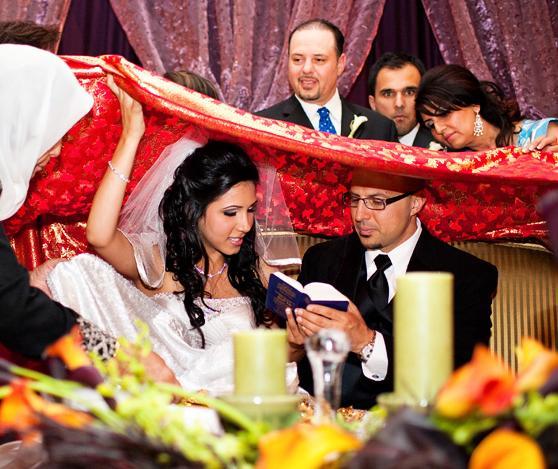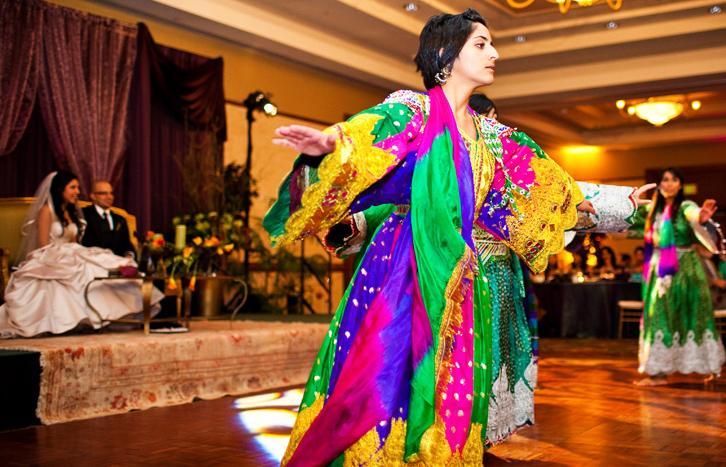Traditional Afghan weddings are unlike a typical wedding that Americans experience here in the United States. They are unique and full of customs and rituals that are special to the people of Afghanistan. The origin of these traditional weddings date back to the wedding ceremony between King Khan and Queen Tarzi in the 1900’s. Since this marriage, Afghans perform their weddings as a mirror image of it. Like the many other traditions in Afghanistan life, wedding ceremony rituals are held near and dear to their hearts.
It all begins when a girl turns ten years of age. At this time, families of the girl “scope” out a potential husband for their daughter. The groom may be any male the family sees suitable, but he must be within their social class. The groom may also be a close relative – as close as a first cousin. If a first cousin is not available, second and third cousins are considered before moving outside of the family. The final decision on a husband depends on a few factors: age, appearance, sectarian membership, ethnic and educational background, and his ability to support a family.
When a potential husband is found, it is the bride’s father who communicates the interest to the boy’s family. Before this occurs, the family confronts the daughter for her approval of her prospective husband. When she agrees, her father approaches the father of the boy and proposes the idea. If the father and the family are interested in the girl as a wife for their son, they will then present a formal proposal to the girl’s father. When he accepts, the engagement is announced. Celebrations are planned accordingly; they may include a dinner or party, and sugar-based foods are served as a symbol of happiness.
The marriage cannot actually proceed until the girl turns sixteen years of age. Usually before the wedding takes place, a “bride price” must be paid from the groom’s family to the bride’s family. The bride price can be in the form of money, property, or livestock. This is done in order to ensure economic and reproductive services of the bride to the groom. Although usually paid for with money, bride price may vary depending in the ethnic group. For example, Arabs are known to pay their price with two feasts, one for the engagement celebration and one for the wedding ceremony. These feasts are usually very large, consist of many guests, and are saturated with plenty of food and drink.
The actual wedding takes place at night; usually starting around six o’clock PM. Dinner is served to family and friends in the absence of the bride. She waits patiently until the dinner is over to enter. Dinner for the guests may include several different items such as: rice, kabobs, authentic bread, and cake. She and the groom enter the hall together, when dinner is finished, around nine o’clock PM. Prior to their entrance, a song called “Ahesta Boro” is sung. They walk slowly through the crowd of family and friends and simultaneously take a seat on a sofa reserved for them. The sofa is decorated elaborately, including assemblies of flowers and candles surrounding it.

The commitment ceremony begins when the song is over. At this time, the bride and groom’s heads are covered with a shawl. Under the shawl, a mirror is placed in front of the couple and the groom will gaze at his bride’s face through the mirror. Together, they read a prayer from the Holy Quran. When the prayer ceases, the shawl is removed and a second song, “Hena Beyarin bar Dastash gozarain,” is sung. This translates into “Bring Henna.” In the present time, a red colored dye, called Henna, is placed on the hand in intricate and detailed patterns. Henna has replaced an ancient tradition. In the past, the bride and groom would cut their palms so that they could be joined in blood. Because this was unsanitary and led to infection, it was done away with. The bride’s henna is done by the groom’s mother, and the groom’s henna is done by the bride’s mother.

Dancing and partying follow the henna application, and lasts till approximately eleven o’clock PM. Towards the end of the ceremony, “Attan” is performed. Attan is a traditional Afghan dance executed in a large circle created by the guests. Each person follows each other around and around while the beat speeds up and slows down continuously. When Attan is through, the bride and groom give their thanks to their guests as they leave the wedding hall.

Wedding traditions throughout the world are extremely diverse. Weddings in Afghanistan are unique and special occasions that are very important to the Afghan people, but tend to differ from other parts of the country. Wedding customs vary tremendously across the globe. But no matter the rituals that take place, one main point is shared between all countries – the meaning behind a “wedding.” Love, compassion, and support are found in every wedding in every culture.
By: Amanda Jablonski